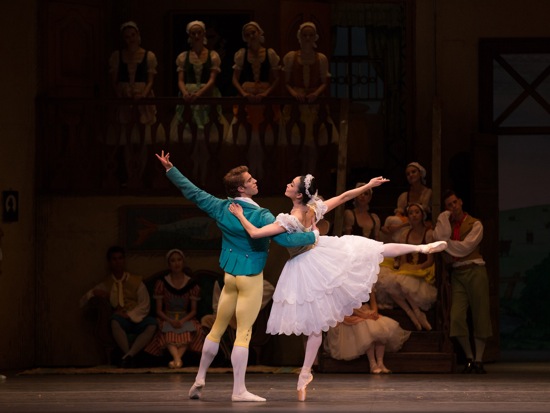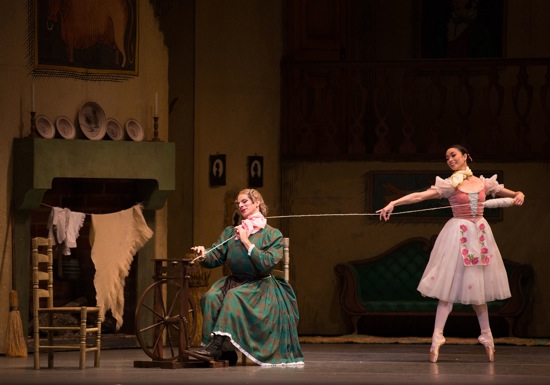American Ballet Theatre revives its production of Frederick Ashton’s La Fille mal gardée.

James Whiteside and Stella Abrera of American Ballet Theatre as Colas and Lise in Frederick Ashton’s La Fille mal gardée. Photo: Rosalie O’Connor
If I had been able to write about American Ballet Theatre’s production of Frederick Ashton’s La Fille Mal Gardée before the company’s performances of it ended on May 30, I would have said, “if you’re having a bad day, go see this ballet.” So fragrant, so tender is its depiction of love, innocence, mischief, and good-heartedness that the landscape it evokes seems perfectly believable, even when a rooster and his hens turn out to be diligent dancers.
Numerous versions of La Fille mal gardée followed its premiere in Bordeaux on July 1, 1789. The storming of the Bastille occurred two weeks later. While there’s no proof that the ballet’s choreographer, Jean Dauberval, was making a political statement, its scenario—unlike those propelling other ballets of the day— was not about the aristocracy but about farmers and a love that counted among the hay fields’ summer harvests.
In 1960, the year that Ashton’s Fille mal gardée was first performed by Brtitain’s Royal Ballet, the choreographer wrote that while reading the journals of William Wordsworth’s sister, Dorothy, he had been “swept by a longing for the country of the later eighteenth and early nineteenth century.” He also said that “There exists in my imagination a life in the country of eternally late spring, a leafy pastoral of perpetual sunshine and the humming of bees—the suspended stillness of a Constable landscape of my beloved Suffolk, luminous and calm.” He called his La Fille mal gardée his “poor man’s Pastorale Symphony” and often listened to that sixth symphony of Beethoven’s while he was preparing his work. And “from him I got the accumulative waves of movement that I tried to put into my ballet.”
The story is simple enough. Widow Simone, a well-do-do farmer, plans to marry her only daughter, Lise, to Alain, the son of Thomas, an even richer vintner. Unaware of this (and also very aware that Alain has what amounts to a child’s mind inside a man’s body), Lise enjoys flirting with Colas, a scamp of a young farmer who is determined to have her despite her mother’s disapproval. In the end, Lise and Colas are united by an unplanned moral decision. Simone has locked her wayward daughter in the house, but her wooer returns, hidden by his pals among the sheaves they have brought in. Once Lise is alone, he bursts ardently forth, but is forced to hide when a crowd is is heard at the door. The fireplace being too hot and a bureau drawer too small, she shoves him upstairs and into her bedroom. Oh-oh. She’s ordered to go get ready for her wedding, which means that when Alain reluctantly knocks on her door, she and Colas are discovered in flagrante delicto (or what passed for it among the virtuous peasants of 19th-century ballets). So they have to get married.
John Lanchbery drew on what could be found of Ferdinand Hérold’s’s score for the 1828 version of the ballet, but much of it was his own. It supports the drama as well as the dancing. The instruments warble morning bird calls in the overture. They clash furiously in the storm that ends Act 1, scene 2 and sends the revelers rushing around. The bassoon (or was it the tuba?) underscores Alain’s clumsiness. And when one of the young men plays a flute for his chums to dance to, the orchestra magnifies his efforts.
The cast I saw (there were four) featured Stella Abrera as Lise, James Whiteside as Colas, Aaron Scott as Alain, and. . . wait for it. . .Marcelo Gomes as the Widow Simone. ABT doesn’t have character dancers on its roster, so Gomes of the princely bearing and the elegant technique essays a different type of virtuosity—one that involves a bonnet, a padded bosom and butt, and a great deal of acting, both subtle and outrageous. He nails every no-nonsense finger-shaking, dignified making-nice, furious lamenting, and most of the nuances between them. And if he’s not the best ever to master Ashton’s delicious Lancashire clog dance, he’s excellent enough, and his delight is palpable as he romps at the harvest fest with four maidens whose neat clogs double as pointe shoes.

Lise (Stella Abrera) helps her mother (Marcelo Gomes) with the spinning. Photo: Rosalie O’Connor
Malin Thoors staged this production of the ballet and deserves much credit for the niceties of emotion and pantomime that mark the developing and falling apart of relationships. How, for instance, does a girl churn dutifully but petulantly? How does a young man sneak unobserved into, and out of, a duet that the girl he loves is performing with an impish, unsuitable suitor. Abrera and Whiteside not only dance with beautiful fluency and clarity, they manage with conviction the changing emotions of this meant-for-each-other couple, whom we easily imagine to be teenagers. Arron Scott excels in the comical role of Alain, who cherishes his red umbrella so much that he’d sooner lose his bride-to-be than that beloved object. This is not an easy role (and hardly a politically correct one), but Ashton made for Alain an eccentric solo that shows his sly wit and nimble feet, as well as his simple-mindedness. And one of the most touching moments is the one in which his fat, pompous father (Thomas Forster) pats his son’s cowlick sadly and affectionately when it becomes obvious that he’s not going to marry pretty Lise after all.
Ashton, as always, created marvelous dancing for all his characters. His scenario, like the original one, allots plenty of time for group celebration; his peasants in clean, bright-colored attire dance wielding sickles, perform maneuvers linked by holding small sticks, and join to make a maypole. Colas shows his nimble footwork by dancing between around and over two wine bottles. When the leading characters perform alone or together, their feet are busy, their bodies expressive, and he puts classical steps together in innovative ways—surprising you with a beginning that turns unpredictable, or an ending that isn’t one. He had some lovely ideas. When Lise is locked in the house, Colas appears at the transom above the door, reaching down to lift her and swing her off the floor, as well as turning her on one toe to show that, if love can conquer restraints, so can a pas de deux.
Ribbons become a running them. Lise finds the crook that Colas has decorated with a lover’s knot—reason enough to dance happily. Finding her momentarily alone, he invents games with a longer ribbon. She can turn rapidly within it, getting closer and closer to him as it furls around her. It can be rippled like a little river. He can take the middle of it between his teeth and play horsey to the driver he loves. In addition to the maypole dance, there’s another, much more innovative ribbon number, into the center of which Lise steps—taking in one hand the ends of all the ribbons fanned out around her by her girlfriends; there she stands in attitude on one toe, unwavering as they walk in circle around her, rotating her in the process. It’s a beautiful image, as trustful as it is virtuosic.
It’s interesting to ponder how much 19th-century European choreographers knew about one another’s work. I think of the storm in August Bournonville’s 1846 Napoli, as well as his own possible influences on later choreographers. One of the solos in Napoli’s last act features the same piquant pauses in the steps and music that characterize one of Ashton’s solos for Lise. His ballet as a whole acknowledges many of those pretty, good-at-heart predecessors, with everyone dressed up for some festival or other, and happy endings obtained at some cost and with a bit of suspense. In the last- act duet for Lise and Colas, he lifts her and bears her across the stage; we know she’s a dead weight (she doesn’t help him with a preparatory spring), but she looks as light as air. You can believe that he’s teaching her to fly, and eventually he lifts her higher. What better metaphor for love?

I wasn’t having a bad morning, but reading your beautiful review made it brighter, I am still smiling. Wish I could have seen the ballet but reading and imagining are also enjoyable! Thanks, Deborah.
Thanks for the lovely, lucid review of this Ashton masterwork. I’m so glad you singled out the “transom” pas de deux (I’m not sure what to call it) in which Colas swings Lise gently back and forth. I’m sure you know this, but just wanted to add that the truly wonderful mime scene in the last act was taught to Ashton by Karsavina who danced a version in Russia. Yet, its tenderness seems so very much Ashton’s — especially the three kisses up the arm — which Alastair Macaulay was told should be on the sensitive inside of the wrist and arm. ( I think by Alexander Grant) Also all credit to one of my heroes, Ivor Guest, who helped Ashton and Lanchberry to research the ballet and find the Herold score in Paris. I remember talking to Ivor about this and his adventures in Paris and I thought “My gosh, that has got to be one of the greatest contributions of ANY dance historian — to actually help a choreographer to create a masterwork. I”ll never, ever get that chance!” It has always seemed to me an example of the most exciting things a dance historian has ever had the opportunity to do.
In any case, thanks again for the lovely review.